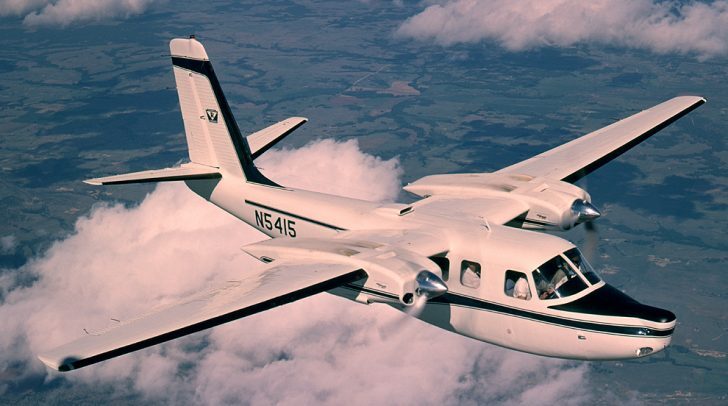By Barry Collman

Scanned from an un-numbered negative in a Factory collection, N5415 is s/n 680F-1139-77, the fourth example of the 680F(P). It is seen here in factory paint design #4-60, in Bluetone White and Baltic Blue, before delivery to Rockwell-Standard Corp., in Coraopolis, Pennsylvania in May 1962. As is clearly evident, it had a Chamberlain 2001K-B radome installed, for an RCA AVQ-50 weather radar system. Also evident is the dorsal scoop for the pressurization system and the over-wing exhaust system indicative of the “Speedline” nacelle on Commander models.
The 680F was the eleventh Aero Commander model to be placed into production and, on the face of it, 152 examples were built. Production was active between May 1960 and October 1964, with serial numbers within the range 680F-871-1 through 680F-1447-152. However, 47 of these had an optional pressurization system and were known as the 680F(P).
With serial numbers in the range 680F-1048-56 through 680F-1439-151, the first 33 F(P)s were built by Aero Commander Inc., as a subsidiary of Rockwell-Standard Corporation, and the last 14 by the Aero Commander Division of Rockwell-Standard Corporation.
Of these, one was initially certified in 1961; 20 in 1962; 17 in 1963; 6 in 1964; and 3 in 1965.
Not being a stand-alone model, the 680F(P) is not listed as such on Type Certificate Data Sheet No. 2A4, but was “Approved” by the FAA on June 29, 1962.
A factory document describes the Model 680F(P), under Wing Drawing 5170045, as “a pressurized 680F and as such is identical to the 680F except for cabin pressurization and modification in accordance with Aero Commander Drawing 6100021, Change A. Certified in 1961, per CAR 3, May 15, 1956, Amendments 3-1 thru 3-4”.
Note 5 of the Type Certificate Data Sheet 2A4 says “An optional pressurized version of the Model 680-F designated “680-F (Pressurized)” was approved June 29, 1962. This model is a standard 680-F incorporating a factory modification per Aero Commander Dwg. 610021.”
The Drawing number quoted should read 6100021. And, this Drawing actually originated on April 10, 1961, and the June 29, 1962 date is probably that of a later Revision. To further muddy the waters, the U.K. CAA records give the date on which the modification was authorized as December 6, 1961, saying “This is a pressurized 680F and as such is identical to the 680F except for cabin pressurisation modification in accordance with Aero Commander 6100021, Change A. Certificated in 1961, per CAR 3, May 15, 1956, Amendments 3-1 to 3-4.”
The 680F(P) has 340 hp Lycoming IGSO-540-B1A engines, with 93.5-inch-diameter three-blade Hartzell HC-B3Z30-2B propeller hubs and 9349 model blades.
Gross Weight is 8,000 lb and the cabin pressure differential is 3.2 psi, giving a 16,297-ft cabin at 28,500 ft MSL and a sea-level cabin at 6,636 ft MSL.
They can be visually identified by having a dorsal scoop on the top of the fuselage just aft of the wing trailing edge, and the pilot’s Direct Vision, or storm port in the cockpit side window, being suitably strengthened or deleted.
Five examples of the 680F(P) have been modified to Mr. RPM (Richard P. MacCoon) “Turbo 800” under STC SA2891WE. These had the 400 hp Lycoming IO-720-B1B engines, modified with the installation of a Rajay turbocharger system under STC SE62WE, coupled with 80.625-inch-diameter Hartzell HC-A3VK-2A/V8433-4R propellers.

Scanned from a negative taken by Barry Collman, N198JW is s/n 680F-1132-75, the third example of the 680F(P) produced. It is seen here in Nashville, Tennessee, on June 20, 1997, while attending the Twin Commander Flight Group Fly-In. First certificated on January 31, 1962, it was sold via a distributor (Commander Aviation Inc., in Pontiac, Michigan), to The Dow Chemical Company, of Midland, Michigan, after the Chamberlain 2001X nose radome had been installed in accordance with STC No. SA1-143. The suitably strengthened “Direct Vision” or storm port in the pilot’s side window is clearly evident. Some examples omitted this feature.
Barry Collman’s lifelong interest in airplanes began when he was growing up in a house located underneath the downwind leg to busy Northolt aerodrome, an R.A.F. base near London-Heathrow airport. As a young teenager he discovered airplane “spotting”–hobbyists’ observation and logging of aircraft by make, model, and registration number. The hobby began to grow into a passion as Collman joined a club of like-minded spotters. At one point he purchased a copy of the January 1966 U.S. Civil Aircraft Register, and thumbing through it came upon the Aero Commander. He was hooked. Eventually he acquired every available FAA microfiche file on Commanders, and since 1995 has made annual pilgrimages to Oklahoma City to sift through FAA records. He now has a database with more than 96,100 records as well as a collection of negatives, slides, photographs, digital images, magazines, brochures, knick-knacks–and a very understanding wife. This series on Commander production history originally was written for the Twin Commander Flight Group, of which he is an enthusiastic member.
